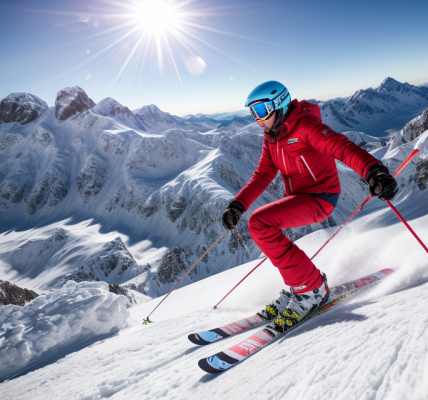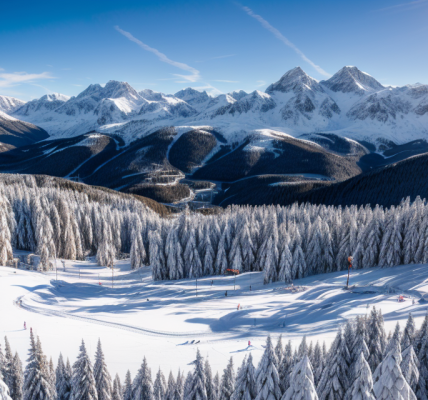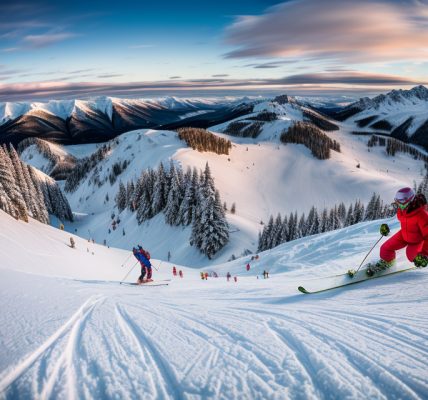Are you ready to hit the slopes and show off your skiing skills? But have you ever wondered what a skiing approach is and why it’s important? In this article, we’ll dive into the world of skiing and explore the significance of a proper skiing approach. Whether you’re a beginner or an experienced skier, understanding the basics of a skiing approach is crucial for a smooth and enjoyable ride down the mountain. So, let’s get started and discover what a skiing approach is all about!
A skiing approach refers to the mindset and techniques used by skiers to tackle different types of terrain and snow conditions. It involves a combination of physical and mental skills, including balance, coordination, and decision-making. A good skiing approach is important because it allows skiers to safely and efficiently navigate challenging terrain, avoid accidents, and maximize their enjoyment of the sport. By developing a strong skiing approach, skiers can improve their overall skiing ability and become more confident and proficient on the slopes.
Understanding the Skiing Approach
The Basics of Skiing Technique
The basics of skiing technique involve understanding the importance of balance and control, as well as the role of the upper and lower body in proper skiing form. These elements are crucial for creating a smooth and efficient skiing approach that allows the skier to move gracefully and confidently down the mountain.
- Balance and Control: Balance and control are essential components of skiing technique. A skier who lacks balance will struggle to maintain control and may be prone to falling. Conversely, a skier who has excellent balance can more easily maintain control and make adjustments to their skiing approach as needed.
- Upper and Lower Body: The upper and lower body work together to create a proper skiing stance. The upper body should be upright and centered over the hips, with the shoulders relaxed and the head facing forward. The lower body should be slightly bent at the knees, with the weight distributed evenly on the skis.
- Mechanics of a Proper Skiing Stance: The mechanics of a proper skiing stance involve a number of key elements. The skis should be positioned slightly apart, with the feet slightly pointed outward. The shins should be pressed against the front of the boots, and the knees should be slightly bent. The upper body should be centered over the hips, with the weight distributed evenly on the skis. This stance allows the skier to maintain balance and control while skiing, and to make smooth and efficient turns.
The Different Types of Skiing Approaches
There are three main types of skiing approaches: parallel skiing approach, skating skiing approach, and telemark skiing approach. Each type of approach has its own unique characteristics and requires different skills and techniques.
- Parallel Skiing Approach: This approach is characterized by the skier’s feet being positioned parallel to each other, with the knees and hips bent slightly. This approach is used for downhill skiing and is the most commonly used approach in alpine skiing. The parallel skiing approach requires a high level of balance, coordination, and control, as well as strong leg muscles.
- Skating Skiing Approach: This approach is characterized by the skier’s feet moving in a figure-eight pattern, with the skis moving in a V-shape. This approach is used for cross-country skiing and is also known as classic skiing. The skating skiing approach requires a high level of endurance, as well as good technique and coordination.
- Telemark Skiing Approach: This approach is characterized by the skier’s heel being unlocked, allowing the ski to be lifted from the snow. This approach is used for telemark skiing, which is a style of skiing that originated in Norway. The telemark skiing approach requires a high level of balance, coordination, and control, as well as strong leg muscles.
Each type of skiing approach has its own unique challenges and requires different skills and techniques. It is important for skiers to understand the different types of skiing approaches and to choose the right approach for their skill level and the type of skiing they want to do.
The Benefits of a Proper Skiing Approach
Improved Safety on the Slopes
- Reducing the risk of accidents and injuries: A proper skiing approach involves a focused and controlled technique, which significantly reduces the likelihood of accidents and injuries on the slopes. By maintaining a stable and balanced stance, skiers can avoid sudden movements or loss of control that could lead to collisions or falls.
- Better control and avoidance of obstacles: Skiing obstacles, such as rocks, trees, or other skiers, can be dangerous if not approached with caution. A proper skiing approach allows skiers to maintain better control over their speed and direction, enabling them to easily maneuver around or avoid obstacles. This skill is particularly crucial for advanced skiers who navigate more challenging terrain.
- Reduced fatigue and exhaustion: Skiing requires physical effort, and a proper approach can help reduce fatigue and exhaustion over time. By conserving energy through efficient movements and reducing the risk of accidents, skiers can enjoy a more enjoyable and sustainable experience on the slopes. Moreover, a proper skiing approach also allows for more efficient transitions between skiing techniques, reducing the overall physical strain on the skier’s body.
Enhanced Skiing Performance
Improving one’s skiing approach can lead to significant gains in performance on the slopes. A proper skiing approach can help a skier achieve greater speed, agility, maneuverability, and turn control. Here are some ways in which a skiing approach can enhance one’s skiing performance:
Increased speed and agility
A proper skiing approach can help a skier generate more power and speed, allowing them to move down the mountain more quickly and efficiently. By developing a strong and effective skiing technique, a skier can generate more force and transfer it into their turns, enabling them to maintain higher speeds with greater control. Additionally, a proper skiing approach can help a skier improve their agility and ability to respond quickly to changes in terrain or snow conditions, enabling them to make faster and more precise movements.
Better maneuverability and turn control
A proper skiing approach can also improve a skier’s maneuverability and turn control. By developing a strong and effective skiing technique, a skier can develop greater control over their skis and the snow, enabling them to make tighter turns and more accurately navigate through the mountain. Additionally, a proper skiing approach can help a skier develop better balance and stability, allowing them to make smoother and more efficient turns.
Greater endurance and stamina
Finally, a proper skiing approach can help a skier develop greater endurance and stamina, enabling them to ski for longer periods of time without fatiguing. By developing a strong and effective skiing technique, a skier can reduce the energy expended in each skiing movement, allowing them to conserve energy and ski for longer periods of time. Additionally, a proper skiing approach can help a skier develop better breathing and pacing techniques, enabling them to maintain their energy levels and avoid exhaustion.
Improved Confidence and Enjoyment of the Sport
Improved confidence and enjoyment of the sport are significant benefits of a proper skiing approach. A proper skiing approach involves a systematic and structured method of approaching the sport, which can lead to improved confidence and enjoyment of the sport. Here are some reasons why:
- Reduced fear and anxiety: A proper skiing approach can help reduce fear and anxiety associated with skiing. When a skier has a systematic and structured method of approaching the sport, they are less likely to feel overwhelmed and anxious. This, in turn, can lead to a more enjoyable skiing experience.
- Increased comfort and control: A proper skiing approach can also increase comfort and control on the slopes. When a skier has a systematic and structured method of approaching the sport, they are more likely to have a better understanding of their body position, balance, and movement. This can lead to increased comfort and control on the slopes, which can also enhance the overall skiing experience.
- Enhanced overall skiing experience: A proper skiing approach can enhance the overall skiing experience. When a skier has a systematic and structured method of approaching the sport, they are more likely to have a better understanding of the sport and its techniques. This can lead to an enhanced overall skiing experience, as the skier is more likely to feel confident and in control, which can lead to a more enjoyable skiing experience.
Overall, a proper skiing approach can lead to improved confidence and enjoyment of the sport. By reducing fear and anxiety, increasing comfort and control, and enhancing the overall skiing experience, a proper skiing approach can help skiers of all levels improve their skills and enjoy the sport more fully.
Developing a Strong Skiing Approach
Warm-Up and Stretching
The Importance of Proper Warm-Up and Stretching
Skiing is a physically demanding sport that requires strength, endurance, and flexibility. Before hitting the slopes, it’s crucial to properly warm up and stretch to prevent injuries and improve performance. A proper warm-up and stretching routine can help increase blood flow to the muscles, reduce the risk of muscle strain, and improve flexibility and range of motion.
Exercises to Improve Flexibility and Range of Motion
There are several exercises that can be done to improve flexibility and range of motion before skiing. These exercises can be done both on and off the snow.
- Static Stretching: This type of stretching involves holding a stretch for a set amount of time to improve flexibility. Examples of static stretches for skiing include toe touches, hamstring stretches, and quadricep stretches.
- Dynamic Stretching: This type of stretching involves active movements to improve flexibility and range of motion. Examples of dynamic stretches for skiing include leg swings, arm circles, and hip openers.
- Mobility Exercises: Mobility exercises are designed to improve range of motion and joint flexibility. Examples of mobility exercises for skiing include hip openers, ankle circles, and spinal twists.
Preventing Common Skiing Injuries
In addition to improving flexibility and range of motion, a proper warm-up and stretching routine can also help prevent common skiing injuries. Skiing can put a lot of stress on the knees, hips, and back, so it’s important to prepare these areas before hitting the slopes. Some exercises that can help prevent skiing injuries include:
- Knee Sweeps: This exercise can help improve knee mobility and reduce the risk of knee injuries.
- Hip Openers: Hip openers can help improve hip mobility and reduce the risk of hip injuries.
- Back Extensions: Back extensions can help improve spinal mobility and reduce the risk of back injuries.
Overall, a proper warm-up and stretching routine is essential for skiers of all levels. By taking the time to properly prepare before hitting the slopes, skiers can improve their performance, reduce their risk of injury, and have a more enjoyable skiing experience.
Building Strength and Endurance
In order to develop a strong skiing approach, it is important to focus on building both strength and endurance. This will allow you to tackle more challenging slopes and enjoy a more enjoyable and safe skiing experience.
Strength Training Exercises for Skiing
There are several strength training exercises that are particularly effective for skiing. These include:
- Squats: Building strength in your legs is essential for maintaining proper form and control while skiing. Squats are a great exercise for targeting the quadriceps, hamstrings, and glutes.
- Deadlifts: Deadlifts are another effective exercise for building strength in your legs and back. This exercise can help improve your balance and stability on the slopes.
- Lunges: Lunges are a great exercise for targeting the muscles in your legs and core. They can help improve your overall skiing performance by building strength and endurance.
Cardiovascular Exercises to Improve Endurance
In addition to strength training, it is also important to incorporate cardiovascular exercises into your training regimen. This will help improve your endurance and overall fitness level, which is crucial for skiing.
Some effective cardiovascular exercises for skiing include:
- Running: Running is a great way to improve your cardiovascular fitness and endurance. It can also help build strength in your legs, which is essential for skiing.
- Cycling: Cycling is another excellent cardiovascular exercise that can help improve your endurance and overall fitness level. It is also low-impact, which makes it a great option for those who are recovering from an injury.
- Swimming: Swimming is a low-impact exercise that can help improve your cardiovascular fitness and endurance. It is also a great way to build strength in your core and upper body, which can help improve your skiing performance.
Gradual Progression to Avoid Injury
It is important to gradually progress your training regimen in order to avoid injury. This means starting with easier exercises and gradually increasing the intensity and difficulty over time. It is also important to allow for proper recovery between workouts to avoid overtraining and injury.
In conclusion, building strength and endurance is crucial for developing a strong skiing approach. By incorporating a combination of strength training and cardiovascular exercises into your training regimen, and gradually progressing over time, you can improve your skiing performance and enjoy a safer and more enjoyable experience on the slopes.
Practicing Technique and Form
Practicing technique and form is an essential aspect of developing a strong skiing approach. To perfect your skiing approach, you need to focus on improving your balance, control, and technique. Here are some tips for practicing technique and form:
- Tips for perfecting the skiing approach
- Start with the basics: Begin by mastering the fundamentals of skiing, such as the stance, posture, and balance. These are the building blocks of a strong skiing approach.
- Focus on body positioning: Your body positioning is critical to your skiing approach. Ensure that your weight is evenly distributed on your skis, and your knees are slightly bent. This will help you maintain balance and control.
- Use the proper equipment: Ensure that you are using the correct equipment for your skiing approach. Your skis, boots, and poles should be properly adjusted to fit your body size and skiing style.
- Drills to improve balance and control
- Balance exercises: Practice balance exercises, such as standing on one leg or standing on a narrow surface, to improve your stability on the slopes.
- Edge control drills: Edge control is crucial to your skiing approach. Practice edge control drills, such as pivoting and shifting your weight, to improve your edge control.
- Mental imagery: Use mental imagery to enhance your skiing approach. Visualize yourself skiing and imagine yourself making the correct movements and techniques.
- Visualization techniques to enhance performance
- Visualization exercises: Practice visualization exercises, such as imagining yourself skiing through different terrain and conditions, to enhance your performance on the slopes.
- Goal setting: Set specific goals for your skiing approach, such as improving your balance or speed, and work towards achieving them.
- Positive self-talk: Use positive self-talk to enhance your skiing approach. Encourage yourself and focus on your strengths, rather than your weaknesses.
FAQs
1. What is a skiing approach?
A skiing approach refers to the way a skier approaches a slope or a feature on the mountain. It includes the position of the skier’s body, the angle of the skis, and the direction of the skier’s momentum. A good skiing approach can make a big difference in the control and stability of a skier on the mountain.
2. Why is a skiing approach important?
A proper skiing approach is important because it helps a skier maintain control and balance on the mountain. It can also help a skier avoid accidents and injuries by allowing them to better navigate difficult terrain and avoid obstacles. Additionally, a good skiing approach can help a skier make the most of their skiing experience by allowing them to ski more efficiently and effectively.
3. What are some key elements of a good skiing approach?
Some key elements of a good skiing approach include proper body positioning, keeping the skis parallel to the slope, and using the appropriate edge angle for the terrain. A skier should also be aware of their speed and momentum, and adjust their approach accordingly. Other important factors include being aware of the conditions of the snow and the layout of the mountain, and using proper skiing technique and form.
4. How can I improve my skiing approach?
To improve your skiing approach, start by paying attention to your body positioning and the angle of your skis. Make sure you are keeping your skis parallel to the slope and using the appropriate edge angle for the terrain. Practice adjusting your speed and momentum to match the conditions of the mountain. Additionally, focus on proper skiing technique and form, and take lessons from a qualified instructor if you can. With practice and patience, you can improve your skiing approach and become a more confident and capable skier.




